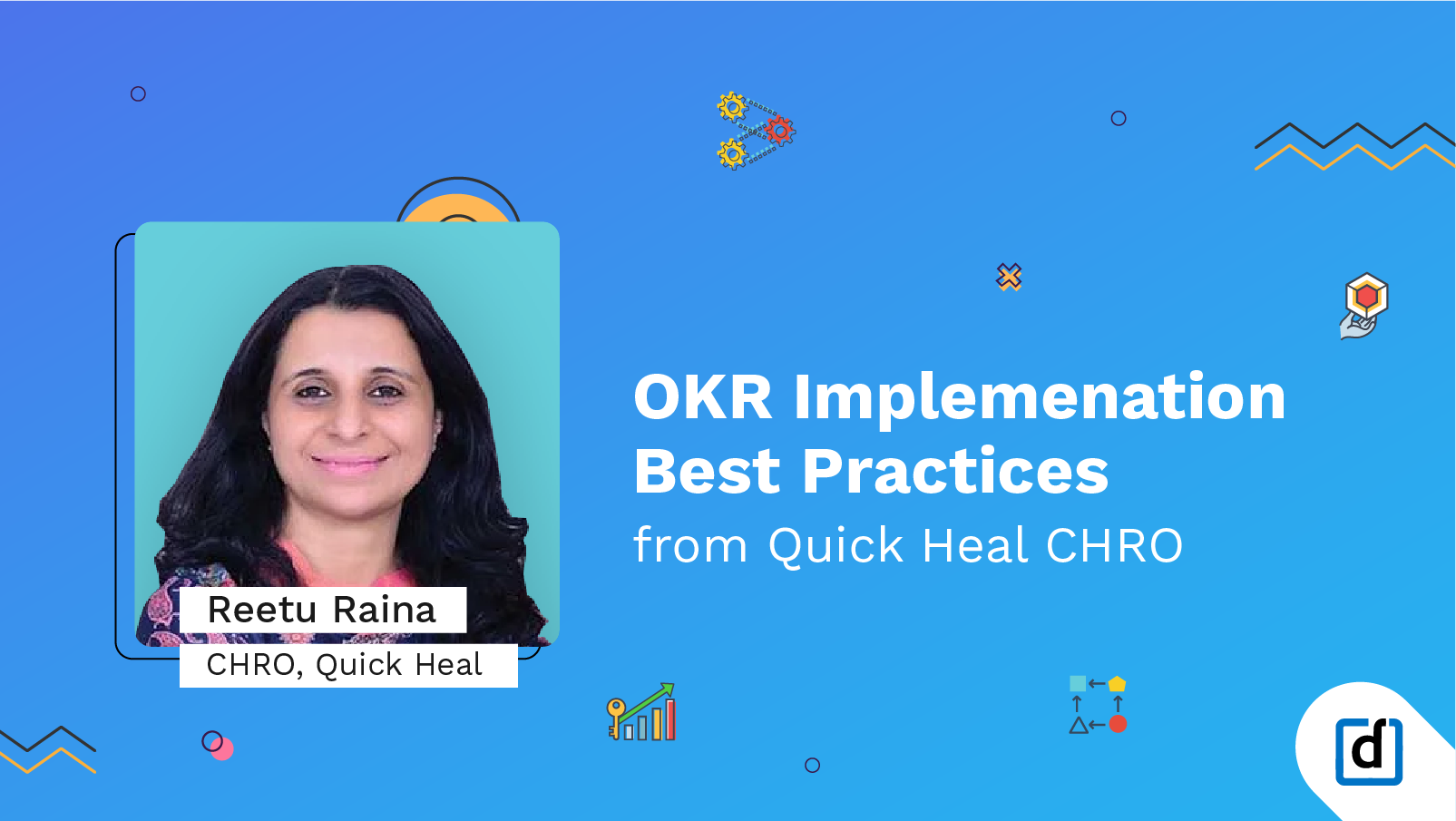

OKR is a performance framework ideal for modern organisations. It can break down organisational silos, synergise your workforce, and drive everyone together to surpass company objectives. It enables your teams to be agile and makes your performance conversations much more meaningful.
The OKR framework has been adopted by some of the best known behemoths—Google, Facebook, LinkedIn, Amazon, Baidu, Uber, and more . But it’s just as impactful on organisations of any size.
The Quick Heal OKR Journey
Quick Heal has been a leader in the retail antivirus sector for 25 years. In 2019, Quick Heal wanted to pivot their organisation to enhance their capabilities in the enterprise and global markets. Their new strategy called for greater customer focus and cross-departmental collaboration. They identified a key element of their strategy as the right kind of performance framework and decided to shift from an MBO framework to OKRs.
We caught up with Quick Heal CHRO, Reetu Raina, in a webinar to talk about their OKR journey, and she shed some light on some of her and Quick Heal’s experience in implementing an OKR programme successfully.
Presented here are some best practices and advice on implementing OKRs that we picked up from her.
1. Making the case for OKR to the CEO
One of the drawbacks of an MBO kind of framework is the tendency to get caught up in chasing numbers. An objective is set as a SMART goal, and a team or individual races with full determination toward reaching that target.
The focus then becomes on output, and not outcomes. Hence even if employees are hitting 100% of their targets, it doesn’t necessarily mean that the organisation is running at full steam. What’s more, it’s difficult to tie individual effort to larger goals.
In order to be more competitive in the enterprise and global markets, Quick Heal underwent a reorg where they built a “product org” and a “tech org”. The product org could quickly capture customer needs, break those down into engineering requirements, and pass them on to the tech org to deliver.
“Leading organisations keep customers at the centre and build processes around them. OKRs enable everyone to own a shared agenda of keeping the customer happy. Whether designing a product, servicing a call, or answering a query, everyone must come together on that mandate. This ‘shared agenda’ is an essential part of OKRs,” explained Reetu.
The points that made the case for the OKR framework can be boiled down to:
- It is a scientific way of assigning and tracking goals. Each objective can be broken down into multiple key results. Objectives and KRs can be cascaded top-down, bottom-up, and across departments. It becomes easier to tie together individual or departmental outcomes to get an accurate view of the larger picture.
- At any point in time the CEO, or anyone else, can look into the system and see where connections are being made or broken. It fosters a culture of transparency and collaboration.
- It empowers the workforce all the way to the last rung. While objectives remain the same, managers and reportees can adjust KRs in the middle of a performance cycle to suit current business needs. It gives teams more agility and makes check-in conversations far more meaningful, while giving the individual more control over their final review vis a vis what they deliver.
2. Involve everyone in the process
“It was clear that one of the key things to make our strategy work was the right design for PMS. Now, execution is in the hands of the people who are going to use that process for evaluation. It starts from the software engineer and goes up to the CTO. So, it can’t just be 4-5 people who are giving their inputs.”
HR understood that the new framework was going to be an organisation-wide mandate, so it needed the buy-in of as many people as possible.
“First we created a partnership with employees and middle management in the design of the process itself.”
It’s impossible to expect the C-suite to have complete knowledge of what’s happening at an operational level. Your frontline workers will be able to give invaluable insight in fleshing out your OKR framework and related processes.
Besides, as Reetu points out, “People also get defensive when something is not their idea!”
So it’s also a matter of handling competing motivations in order to really convince teams that the shift is in everyone’s best interest. That’s why it’s crucial to involve them in the design stage. Doing so will ensure the process will truly address their needs and they will be truly invested in it.
3. The shift to OKR should be incremental
“Don’t try to win the whole kingdom in one day,” advises Reetu.
The shift from MBO to OKR was going to be a major change in the way the Quick Heal had done things over the last 20+ years. They wanted to move quickly, but at the same time they didn’t want their people to feel like they had the rug pulled out from beneath them.
“Put a simple target in place and break larger milestones into steps. That helped us.”
4. The key to change management is the right communication
In order to get the workforce to get behind any organisational change, it is critical to tell the right story.
Quick Heal knew why they wanted to change to OKR: their ambitious organisational goals. But how is that “why” connected to the employee?
“Our employees’ expectation is simple—'I perform, I deliver, and you reward me.’ And that will happen with more clarity around performance management and the right tool for it.”
Quick Heal conducted plenty of road shows and created in-depth learning modules. The tone of every communication was one of partnership with the workforce.
Furthermore, the Quick Heal team developed training that used real-life, live case studies from the company itself. They hid the names and picked up both correct and incorrect cases of OKR setting. For example, they would demonstrate OKRs for the finance team, and show how they are connected to the CEO and CFO, and so on.
“The more real you are, the more you talk about personas of employees that are actually in the organisation, the more relatable the training will be. This will yield better results.”
5. DON’T PANIC
This is not what you’d call “tactical advice”, but it’s certainly reassuring for your team to hear those words coming from you.
Reetu stressed to her teams, “It’s everyone’s first time, so mistakes are OK.”
Any team transitioning to OKR from another framework will face issues in their first sprint or pilot. Many people may take time to understand OKR goal-setting, even in spite of training. The key to a smooth transition is to portray patience and magnanimity. Give your teams a clap on the back now and then, and when things get stressful get in there to provide guidance and reassurance.
It’s reassuring, at least, to know that even the likes of Quick Heal went through a period of adjustment and hard lessons. No transition is without these.
6. An intuitive tool
“In HR, many times we see a situation where a software stresses us out rather than helping. While selecting a tool, you need to ask, ‘Do we want the system to empower us, or do we want to sit and manage the system?’”
Learning from experience, Reetu says that the usability of the system that will deliver OKR is just as important as the framework itself. A difficult-to-use system becomes a burden on the HR team, which will affect everyone eventually.
“Every system has its own way of working, and at every stage you have to make absolutely sure that everything is input in the right format, and so on. Sometimes I would hear from the team, ‘It’s better to just do it in excel, using the system will take more time.’ What we need is a system that is intelligent enough to understand the input it requires next and to guide us through all the steps.”
Of course, the tool must be intuitive for the employee as well.
“When my employee gets into the HRMS, they should not need HR’s help. The system should be simple and intuitive enough to tell them what to do. The outcome of this process, which is performance management, shouldn’t get impacted because the tool is too complex.”
7. OKR is a culture
“OKR is not an activity, it’s not a change in forms or your HRMS—it’s a philosophy. You need to look beyond its application in a PMS. The PMS is just a tool to execute it. If we want to be successful in future, we have to look at OKR as the key thing to help us get the required results. It has to help employees get clarity around their contribution and to grow in the organisation. Make everyone part of this journey, from CXOs to the last rung.”
This is the most valuable advice to make OKR really stick. It’s more a way of thinking than just a process of executing performance management.
Quick Heal wanted to enable more cross-departmental collaboration and instil greater individual accountability. The leadership wanted to inculcate an objective-oriented culture. It is important to remember that these are the ends, and the PMS is simply the means.
Implementing the culture is a team effort, but someone has to lead it. The direction and vision comes from the top, designing protocols must involve everyone, and then someone has to oversee the change management.
Read up on the results of Quick Heal’s OKR journey in their case study, where they found Darwinbox to be the ideal tool to deliver their OKR framework. You might also find use in our Ultimate OKR Implementation Guide, which is a step-by-step guide to implementing OKRs in your organisation with ready-to-use templates for many of the steps.



Speak Your Mind